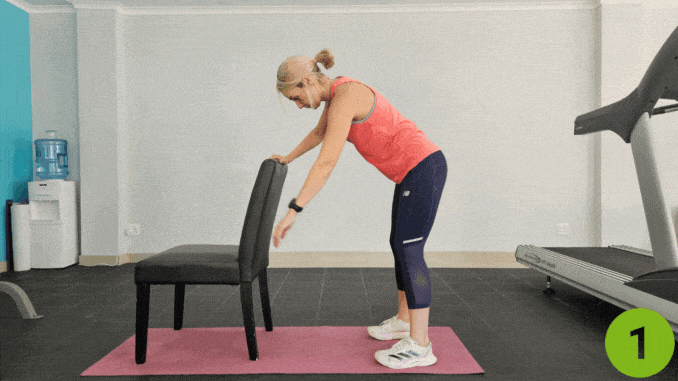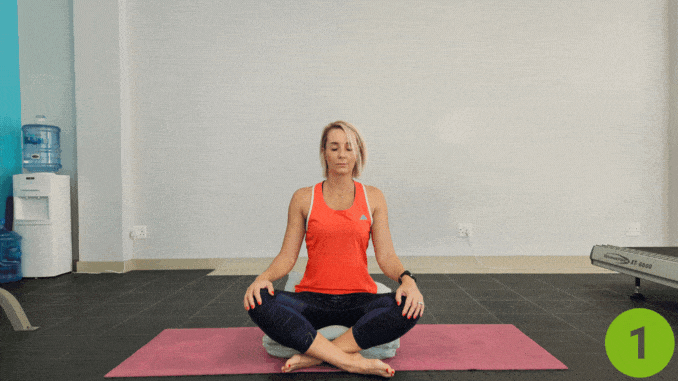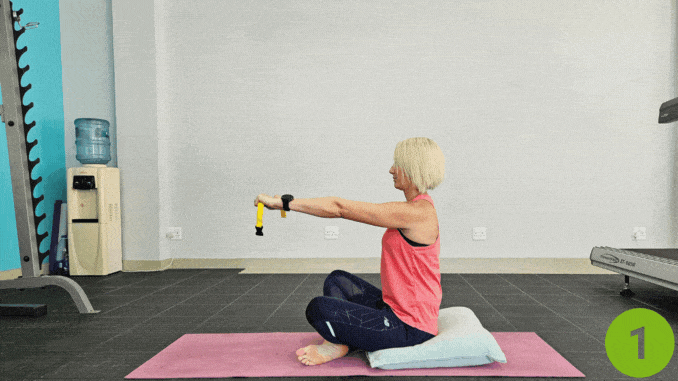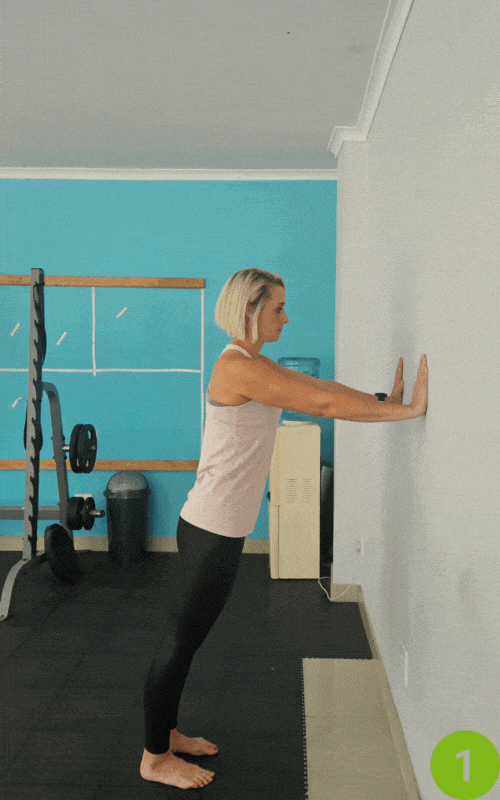Broke your collarbone? Don’t panic—broken collarbone exercises can help you recover without sitting still for weeks.
With the right exercises, you can heal faster, move better, and then feel stronger day by day.
Whether it was a fall, accident, or sports injury, this guide gives you simple, doctor-backed moves that really work.
Ready to bounce back stronger and then pain-free? Let’s get moving—your comeback starts now.
According to Dr. Stuart J. Fischer, MD, once the pain lessens, slowly add gentle shoulder exercises to rebuild strength.
Exercise goals [5]:
- Reduce pain
- Prevent stiffness
- Keep muscles active
- Improve shoulder movement
- Maintain posture
1. Pendulum Arm Swings

- Begin in an upright standing position behind a sturdy chair, maintaining good alignment with your head, shoulders, hips, and then legs.
- Place one hand on the backrest of the chair for support and allow your affected arm to hang down freely in front of your body.
- After that, engage your core.
- Gently swing your hanging arm forward and then backward in a slow, controlled motion.
- Focus on letting gravity do most of the work, keeping your shoulder relaxed.
- Complete 10–15 repetitions, then pause and swing your arm side to side.
- After that, repeat this movement daily.
2. Shoulder Rolls

- Begin in an upright sitting position, maintaining good alignment with your upper body.
- Rest both hands on your upper legs.
- Engage your core during your broken collarbone exercises.
- Shift your shoulders forward, then roll them up and back until you feel resistance in your shoulder blades.
- Relax and then repeat the movement.
3. Shoulder Blade Squeeze

- Begin in an upright sitting position on a stable surface with your legs comfortably crossed in front of you, maintaining good alignment with your head, shoulders, and then hips.
- Sit on a cushion or folded towel for comfort and support.
- After that, extend your arms straight out in front of you at shoulder height while holding a light resistance band or small towel for added control.
- Engage your core.
- Pull your arms back by squeezing your shoulder blades together, keeping your elbows slightly bent and then your chest open.
- As part of your broken collarbone exercises, hold this position for 2–3 seconds.
- Slowly return to the starting position and then repeat the movement.
- Complete 10 repetitions.
4. Towel Neck Stretch

- Begin in an upright standing or sitting position, maintaining good alignment of your head, shoulders and then hips.
- Tighten your core.
- Hold the towel with both hands, placing it behind your head.
- Gently tilt your head backward, using the towel to support the stretch.
- Moreover, feel the stretch along the front of your neck.
- Hold this position for 15-30 seconds, and then repeat the movement.
Note: Be careful not to strain your neck
5. Arm Raises

- Begin in an upright standing position with your feet hip-width apart, maintaining good alignment with your head, shoulders, hips, and then legs.
- For broken collarbone exercises, rest your arms at your sides.
- Engage your core.
- Slowly raise both arms in front of your body and continue lifting them overhead as far as is comfortable, keeping your elbows straight.
- Pause briefly at the top of the movement, ensuring your elbows remain slightly bent, then slowly lower your arms back to the starting position.
- After that, repeat the movement.
- Complete 10 repetitions.
6. Cross-Body Arm Stretch

- Begin in an upright standing position with your feet shoulder-width apart, maintaining good alignment with your head, shoulders, hips, and legs.
- After that, contract your core.
- Reach across your chest with one arm and use your other hand to pull your arm closer to your body, looking for a light stretch.
- Place your chin on the other shoulder.
- Hold this position for several deep belly breaths, in through your nose and then out through your mouth.
- Relax and then repeat the movement on the opposite side.
7. Wall Push-Ups

- Begin in an upright standing position facing a wall, with your feet hip-width apart and about 1–2 feet away from the wall.
- Maintain good alignment with your head, shoulders, hips, and then legs.
- Place your hands shoulder-width apart on the wall at chest level.
- After that, engage your core.
- Slowly bend your elbows and then lean your body toward the wall in a controlled motion.
- Pause briefly, then push through your hands to return to the starting position.
- Repeat the movement.
- Complete 1–2 sets of 10 repetitions.
What is a Broken Collarbone?
- The clavicle (collarbone) [3] connects the shoulder to the chest.
- A fracture means the bone is broken — often due to a fall, sports injury, or car/bike accident.
- Most breaks occur in the middle third of the collarbone, also known as a midshaft fracture.
Symptoms & Diagnosis
- Pain, swelling, or a visible bump/deformity near the shoulder
- Holding the injured arm for support
- Bruising [4] or cuts may appear
- Doctors check for potential complications:
- X-rays are used to confirm the break and then see how bad it is
Where Does It Break?
The middle part of the bone is the weakest and is most often.
The collarbone has three sections:
- Inner third – closest to the chest
- Middle third – most common break area
- Outer third – near the shoulder
Understanding the Injury

- A clavicle fracture occurs when the collarbone breaks, often due to enough pressure from a fall onto an outstretched arm.
- The injury can be painful and may require surgical repair, especially if the fracture is displaced or comminuted.
- Understanding the nature of the injury is vital for effective rehabilitation and to prevent further complications, such as fractures occurring in other parts of the body.
- A thorough examination by an orthopaedic surgeon or healthcare provider is necessary to determine the best course of treatment for the fractured collarbone.
- The healing process can be influenced by factors such as overall fitness, body mechanics, and the presence of other health conditions.
The big things that she needs to do are focus on shoulder movement and maintaining strength [1] in the shoulder muscles.
What Is The Big Beal About A Broken Collar Bone At Four Years Old?
The collarbone is a small, curved bone that extends from the breastbone to the shoulder.
This fragile and easily broken bone plays an integral role in many movements; it helps move your arm outwards or upwards when reaching for something above you.
When children suffer such injuries early on, there will be some short-term effects, but long-term results can vary as well as how quickly they improve over time with appropriate treatment.
How To Treat Collar Bone?
A broken collarbone is the most common type of shoulder injury.
It heals with ice, arm support, pain medicine, and exercises in most cases.
You can use a sling or a shoulder immobilizer to help your arm heal properly.
A shoulder immobilizer works like a sling but has an additional strap around your waist for added stability.
Will The Collarbone Heal Straight?
Even with broken bones not in the perfect alignment, the body can usually make them straight again.
This is because a thick periosteum (outer layer of bone) on collarbones generally does not break; this typically acts as a sleeve to hold together the fractured parts while they heal.
Sometimes, there may be bumps on whatever arm or shoulder broke – these tend to get smaller and eventually go away within one year in kids who still have time for growth left in them!
Sometimes such bruises will never entirely disappear, but they don’t cause other problems like pain or discomfort [2] when using your arms and shoulders.
Broken collarbones often heal quickly and entirely within a few months.
Your child should be able to do everything they did before the injury in that time frame.
Conclusion
Recovering from a broken collarbone takes time, patience, and the right exercises.
Gentle movements like pendulum swings, arm raises, and wall push-ups help you rebuild strength and regain motion without stressing the healing bone.
Always begin slowly and follow your doctor’s advice.
These simple, low-impact exercises are designed to support your recovery safely.
Stay consistent, listen to your body, and focus on progress, not perfection.
With daily care and gradual movement, you’ll improve flexibility, reduce stiffness, and return to normal activity stronger and more confident.
Healing is possible—one gentle step at a time.
Download our Scapular Stabilization Exercises Guide today and start building a stronger, more stable upper body. Whether you’re recovering from injury or looking to enhance your performance, this easy-to-follow digital resource is your key to pain-free movement.
Frequently Asked Questions
What exercise can I do with a broken collarbone?
After a broken collarbone, you can start with pendulum exercises, where you let your injured arm hang and gently move it in clockwise and counterclockwise circles. These help maintain good shoulder position and improve elbow motion. As you heal, your physical therapist might add isometric shoulder exercises, isometric triceps exercises, and rotator cuff exercises to maintain muscle alignment and prevent loss of bone strength. You’ll also do grip strength exercises and movements for your entire forearm and upper arm.
What helps a broken collarbone heal faster?
To help it heal faster, follow your doctor’s advice and wear a sling to rest your injured shoulder. Start physical therapy early with gentle shoulder exercises to avoid stiffness. Doing light strengthening exercises can maintain muscle and bone strength. A physical therapist will guide you to avoid overuse while still encouraging healing movement. Eating healthy foods rich in calcium and vitamin D also helps maintain proper bone healing.
When to start physical therapy after a broken collarbone?
You usually start physical therapy about 2–4 weeks after the injury, once your doctor says it’s safe. Early therapy includes pendulum exercises, elbow motion, and gentle shoulder exercises. Over time, you’ll progress to isometric triceps exercises, rotator cuff exercises, and light strengthening exercises to build muscle and bone strength without hurting your fractured arm.


